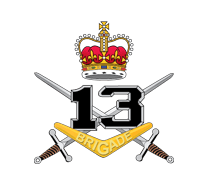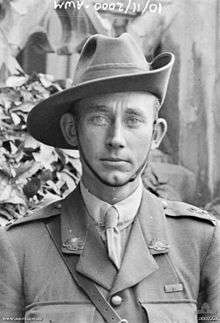13th Brigade (Australia)
| 13th Brigade | |
|---|---|
 | |
| Active |
1916–19 1939–46 1948–60 1988–present |
| Country |
|
| Allegiance |
|
| Branch |
|
| Type | Reserve |
| Size |
100 (Active) 1,350 (Reserve) 30 (Civilian)[1] |
| Garrison/HQ | Perth, Western Australia |
| Engagements | |
| Commanders | |
| Notable commanders |
Brigadier Thomas Glasgow (1916–18) Brigadier Sydney Herring (1918–19) |
The 13th Brigade is an Army Reserve formation of the Australian Army. Originally formed in 1916, the brigade fought on the Western Front during World War I and in the New Britain Campaign during World War II. It is currently headquartered at Perth in Western Australia and has units located across the state in locations such as Geraldton, Kalgoorlie, Albany, Katanning, Joondalup and Rockingham. The current brigade was formed in 1988 and is tasked with the protection of Western Australia. It forms part of the 2nd Division of the Australian Army.
History
World War I
Following the evacuation of Gallipoli in December 1915, the Australian government decided to expand the Australian Imperial Force by creating three additional divisions on top of the two that already existed.[2][3] This was achieved by splitting the battalions of the first four brigades that had fought at Gallipoli to provide an experienced cadre for the new battalions that were being formed. Through this process, the 3rd Infantry Brigade was divided to form the 13th Infantry Brigade. Assigned to the 4th Australian Division, on formation the brigade consisted of four infantry battalions: the 49th, 50th, 51st and 52nd Battalions.[3]

After undertaking a period of training in Egypt where it had been formed, the 13th Brigade sailed from Alexandria for France on 30 March 1916. Upon landing in Marseilles, it was transported north by rail. In mid-May, the brigade entered the front line for the first time, moving into a sector near Petillon, in France. For the next two-and-a-half years, the 13th Brigade took part in the fighting in the trenches along the Western Front in France and Belgium and was engaged in a number of significant actions. Its first major action came at Mouquet Farm in August 1916, which was followed by further actions at Messines and Passchendaele during 1917, and around Dernancourt, on the River Ancre, where the brigade fought a defensive action in early 1918.[5] But, the brigade's most notable action came during the Allied attack on Villers-Bretonneux on 25 April 1918, during the Second Battle of the Somme that took place amidst the German Spring Offensive in early 1918. The brigade's casualties during the offensive were heavy, and as a result one of its battalions – the 52nd – was broken up and its personnel used to reinforce the other three battalions in mid-May 1918.[6] After the German offensive was blunted, the remaining three battalions of the brigade undertook further actions as the Allies went on the offensive, launching their Hundred Days Offensive around Amiens in August. They continued operations into late September, attacking the Hindenburg Line.[7][8] Early the following month, the majority of the Australian Corps brigade was withdrawn from the line for rest.[9]
Following the end of the war the battalions of the 13th Brigade where returned home and disbanded.[7] The brigade's first commanding officer was Brigadier Thomas Glasgow;[5] when Glasgow was promoted to take over command of the 1st Division in June 1918, he was replaced by Sydney Herring, who commanded the brigade throughout the remainder of the war.[10]
Inter-war years and World War II
In 1921, following the conclusion of the demobilisation process, Australia's part-time military force, the Citizens Force, was reorganised to perpetuate the numerical designations of the AIF.[11] As a result, the 13th Brigade was re-raised as part of the 5th Military District, headquartered in Perth, Western Australia, and consisting of the 11th, 16th, 28th, and 44th Infantry Battalions and the 10th Light Horse Regiment.[12] Initially, the Citizens Forces units were maintained through a mixture of voluntary and compulsory service, but throughout the 1920s the compulsory service scheme was adjusted to focus mainly on the populated centres, which meant that the strength of some of the brigade's regional units, such as the 16th Battalion, which was based on the goldfields, was minimal. In late 1929, the scheme was suspended completely by the Scullin Labor government, and replaced by an all-volunteer "Militia" scheme.[13] As a result, the 11th and 16th Battalions were amalgamated in 1930; they remained linked until 1936 when they were both re-raised in their own right again,[14] as part of an expansion of the Australian military due to concerns about war in Europe.[15]
The brigade was mobilised for war service in 1939 after the outbreak of the Second World War, but due to the provisions of the Defence Act (1903) it was initially only used as a garrison force. Up until 1942 the brigade was the main formation defending the Western Australian coastline from a possible Japanese invasion. During this time, the 44th Battalion was detached from the brigade and for the remainder of the war its principle units were the 11th, 16th and 28th Infantry Battalions.[14] In 1943, after the threat of a Japanese landing in the west subsided, the brigade was moved north to the Northern Territory. They remained there until 1944 when the 13th Brigade was transferred from the 4th Division to the 5th,[16] and proceeded overseas to take part in the New Britain campaign against the Japanese, remaining on the island until the end of the war; combat was limited during the campaign, though, as the Australians sought mainly to isolate the Japanese garrison, rather than destroy it. After returning to Australia, the brigade was disbanded in 1946.[14] Between 1940 and mid-1945, the brigade was commanded by Brigadier Eric McKenzie,[17] who, according to the Australian War Memorial, held the longest brigade command of any Australian officer of the war.[18]
Post war
After the Second World War, Australia's wartime military was demobilised and in 1948 the part-time force was re-raised under the guise of the Citizens Military Force.[19] The 13th Brigade was re-raised at this time, once again headquartered in Western Australia. Upon formation, it consisted of two infantry battalions: the 11th/44th and the 16th/28th. In 1960, when the CMF was reorganised following the adoption of the Pentropic divisional establishment,[20] the brigade was disbanded. It was re-raised again in 1988, and is currently responsible for the bulk of Army Reserve formations in Western Australia.[17] Assigned to the 2nd Division, it is headquartered in Perth and commands units across Western Australia, based in places such as Joondalup, Rockingham, Geraldton, Kalgoorlie, Albany and Katanning. The brigade's personnel have deployed on operations to the Solomon Islands, East Timor and Afghanistan and have also been deployed to provide aid to the civil community.[21] Under Plan Beersheba, the brigade is tasked with forming a battlegroup along with the 11th Brigade, to support the Regular Army 3rd Brigade when it is the ready brigade.[22]
Current units
Units of the 13th Brigade currently include:[21]
- 11th/28th Battalion, Royal Western Australia Regiment
- 16th Battalion, Royal Western Australia Regiment
- 13th Field Squadron, Royal Australian Engineers
- 'A' Squadron, 10th Light Horse Regiment
- 13th Combat Services Support Battalion
- 109th Signal Squadron
- 7th Field Battery, Royal Australian Artillery
All units are part of the Army Reserve.[21]
References
- Citations
- ↑ The Australian Army. Modernisation from Beersheba and Beyond (PDF). Commonwealth of Australia. p. 5. Archived from the original (PDF) on 26 March 2015. Retrieved 4 December 2014.
- ↑ Grey 2008, p. 100.
- 1 2 Bean 1941, p. 42.
- ↑ "Clifford William King Sadlier". AIF Project. Australian Defence Force Academy. Archived from the original on 16 February 2012. Retrieved 21 February 2014.
- 1 2 Harry, Ralph (1983). "Glasgow, Sir Thomas William (1876–1955)". Australian Dictionary of Biography. Canberra: Australian National University. Retrieved 21 February 2014.
- ↑ "52nd Battalion". First World War, 1914–1918 units. Australian War Memorial. Retrieved 21 February 2014.
- 1 2 "51st Battalion". First World War, 1914–1918 units. Australian War Memorial. Retrieved 21 February 2014.
- ↑ "49th Battalion". First World War, 1914–1918 units. Australian War Memorial. Retrieved 21 February 2014.
- ↑ Grey 2008, p. 109.
- ↑ Katzmann, Anna (1983). "Herring, Sydney Charles Edgar (1881–1951)". Australian Dictionary of Biography. Canberra: Australian National University. Retrieved 21 February 2014.
- ↑ Grey 2008, p. 125.
- ↑ "Australian Infantry Unit Colour Patches 1921–1949". Digger History. Retrieved 2 February 2014.
- ↑ Shaw 2010, p. 9.
- 1 2 3 "WA Infantry History". Royal Western Australia Regiment Association. Retrieved 21 February 2014.
- ↑ Keogh 1965, pp. 46–50.
- ↑ "11th Battalion (City of Perth Regiment)". Second World War, 1939–1945 units. Australian War Memorial. Retrieved 21 February 2014.
- 1 2 "Unit History – 13th Brigade". Department of Defence. Archived from the original on 21 April 2009. Retrieved 21 February 2014.
- ↑ "28th Battalion (Swan Regiment)". Second World War, 1939–1945 units. Australian War Memorial. Retrieved 16 April 2014.
- ↑ Grey 2008, p. 200.
- ↑ Shaw 2010, p. 10.
- 1 2 3 "13th Brigade". Australian Army. Retrieved 21 February 2014.
- ↑ "The Australian Reservist" (PDF) (22). Defence Reserves Association. April 2014. Retrieved 25 July 2015.
- Bibliography
- Bean, Charles (1941). The Australian Imperial Force in France, 1916. Official History of Australia in the War of 1914–1918. Volume III (12th ed.). Canberra, Australian Capital Territory: Australian War Memorial. OCLC 220623454.
- Grey, Jeffrey (2008). A Military History of Australia (3rd ed.). Melbourne, Victoria: Cambridge University Press. ISBN 978-0-521-69791-0.
- Keogh, Eustace (1965). South West Pacific 1941–45. Melbourne, Victoria: Grayflower Publications. OCLC 7185705.
- Shaw, Peter (2010). "The Evolution of the Infantry State Regiment System in the Army Reserve". Sabretache. Garran, Australian Capital Territory: Military Historical Society of Australia. LI (4 (December)): 5–12. ISSN 0048-8933.